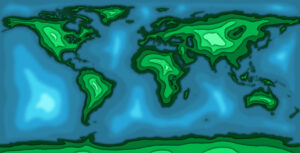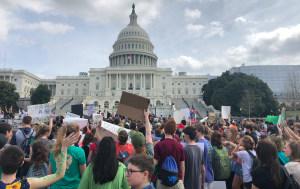The Georgetown Environmental Justice Program brought a Faces of Climate Change art installation to the ICC galleria last week from April 17-22. The exhibit featured works from the Faces of Climate Change photography contest launched by Nishita Karad in 2022, and highlighted stories left out by the “Western-centric narrative” that Karad said exists in the global conversation about climate change.
Karad emphasized that photography has “an especially meaningful connection” to world issues. Georgetown Environmental Justice Program Founder Gaël Giraud also stressed the overlap of arts and sciences in the program’s efforts to combat climate change.
“It is super important to lay out the welcome mat for humanities and arts, and arts and sciences,” Associate Director of the Georgetown Environmental Justice Program Jennifer Eagleton said. “Science gives you the knowledge and data, and art engages the heart.”
According to Karad, Faces of Climate Change has already received submissions from over 90 countries worldwide this year. 100 photos will be selected at large, and there will be one winner in each of the contest’s four categories: ‘Faces of the Bold,’ ‘Faces of the Brave,’ ‘Faces of the Past, Present and Future,’ and ‘Faces of the Unheard.’
The photography features stories of those impacted by climate change across the world, and includes photos ranging from the works of professional photographers to a 10-year-old girl’s iPhone portrait of her grandmother following their family’s relocation due to land erosion.
The Faces of Climate Change exhibition presented raw scenes of communities facing irregular rainfall, drought, flood, and overflowing waste.
“The river is our home,” a 52-year-old Bangladesh fisherman featured in the photograph by Azim Khan Ronnie said. Black and white storm clouds surround the man as he grips the paddle and looks ahead in the photo. Uncertainty plagues his community, which depends on fishing.
“The crisis has become so critical that in 2019 the Supreme Court declared all the country’s rivers to be ‘living entities;’ with anyone damaging them subject to punishment,” Ronnie’s description of the photograph read.
The exhibit also explored the passage of time. Several photographs highlighted global environmental challenges being passed to future generations and the unequal burden borne by different communities.
In one image, Batache Mondol clutches her walking stick and looks solemnly into the camera. Her gray hair blends into the clouds behind her and pops against her tan skin, marked by wrinkles from her 100 years on earth. Behind her is her former home in Bangladesh, where river erosion has rendered her a climate refugee.
Around the corner hung a photo of Cambray Crozier, an American policy analyst and environmental justice advocate, holding her newborn daughter, who will inherit a world shaped by climate change.
Karad also said she sees “hope and positivity” in many of the submissions, along with notes of humanity, and resilience.
Families commute together through knee-high floodwaters in a photograph taken in India by Amitava Chandra. A mother carries her child above the murky water, and two men next to her lift suitcases above their heads. Yet, they cross the water together and smile at one another beneath their masks.
The 2022 winning photograph in the ‘Faces of the Bold’ category shows a geographic information systems expert crouched at the side of a riverbank, looking intently at an instrument used to track plastic waste in the rivers of Tanzania. His work aims to provide evidence to the local government about the need for new waste collection bins and centers which would protect the rivers from further contamination.
In another selected photograph, Adolfo Rodriguez, a professor and milpa farmer from the Mayan community of Maxcanú, holds out a colorful pitaya (dragon fruit). Milpa farming was passed through generations of Mayan descendants on the Yucatán peninsula in Mexico, and helps preserve clean groundwater from chemicals used in other farming techniques. Rodriguez is part of an initiative to pass milpa farming on to future generations and protect the land from deterioration.
Karad said she wishes that more of those impacted by the climate crisis will consider sharing their experience through art. “Believe in the power of your authentic experience,” Karad said, in hopes that increased visibility of climate change stories will drive action for environmental protection. “My hope is by 2050 to have a photobook to show how these stories change.”





